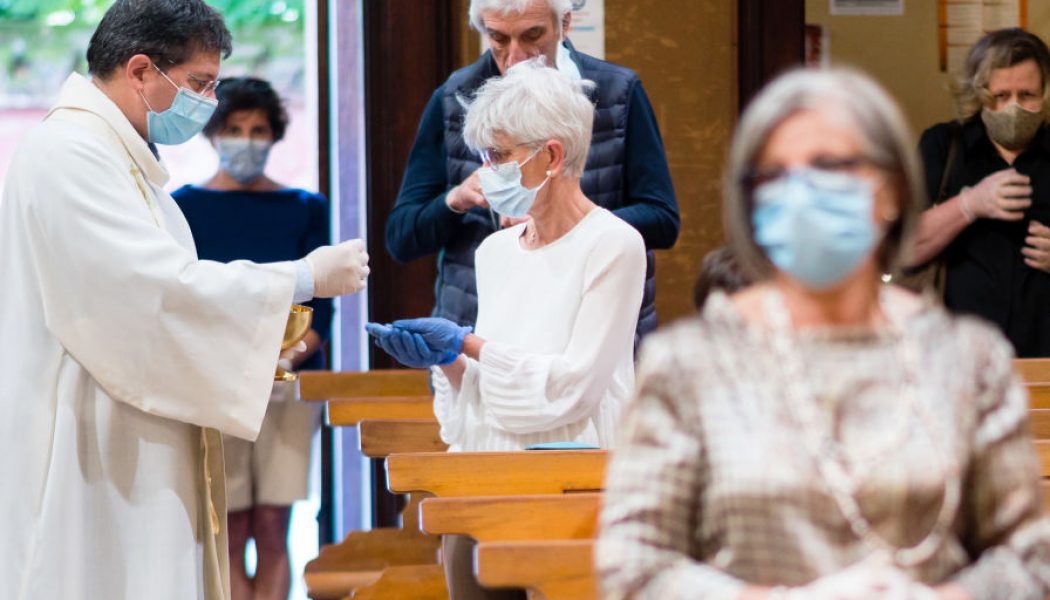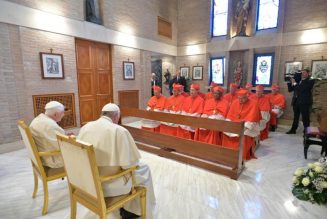
A priest distributes Holy Communion in Spino d’Adda, on May 24, 2020 in Cremona, Italy. (Photo by Marco Mantovani/Getty Images)
What could have been a golden opportunity to preach the Gospel in the midst of suffering has instead brought aggressive church restrictions and flippant liturgical practices.
In recent days I visited a number of churches in Italy and the alpine regions of Germany and Austria and was especially struck by how detrimental the reaction to the coronavirus pandemic had been to worship.
Whereas most public places had become fairly relaxed about precautions to prevent the spread of COVID-19 — few people, for example, wore masks even in supermarkets and on public transport — when it came to churches, measures were strictly enforced.
Most noticeable was that in every church I visited, Communion in the hand was obligatory and vigorously applied, even though its efficacy in terms of providing better hygiene is questionable and, more importantly, various prelates and clergy including Cardinal Robert Sarah have considered Communion in the hand — only ever meant to be a rare exception — to be sacrilegious.
In a church in Bavaria, the sacristan brought out a portable square glass screen during Holy Communion and placed it between the priest and the communicant so that the only way to receive was by placing one’s hands below the screen to receive Holy Communion.
In a church in Florence, the faithful were required to stay seated as the priest distributed Holy Communion to socially distanced faithful in the pews, even though during the offertory, the faithful were invited to walk up to the foot of the altar and place their offering in a basket.
Failure to present one’s hands to receive the host would lead the priest to say “no, only in the hand” (although in that church, all the communicants were allowed to remain kneeling in their pews as they received). A friend who wished to receive but did not present their hands was completely ignored.
None of the churches that I visited had priests wearing disposable gloves, perhaps because most parishioners would not accept such a practice. But in a small church in the Italian town of Bellagio, the pews were entirely sealed off throughout the day, deterring prayer in front of the Blessed Sacrament.
Admittedly, Bellagio is in Lombardy, the hardest-hit region of Italy from March to May, but it now has almost no coronavirus cases and beyond mask-wearing and hand sanitizer, most of the region appeared to be back to normal, apart from a visible lack of tourists for this time of year.
What these measures showed was a seeming lack of appreciation of (or belief in?) the Real Presence of Jesus in the Holy Eucharist, made all the clearer by the priest in almost all cases failing to genuflect when placing or removing consecrated hosts in the tabernacle or walking in front of it. In such circumstances, perhaps it is of no surprise that in the Bellagio church, even merely kneeling to pray in front of the Blessed Sacrament was off-limits to the faithful in the interests of a the “higher good” of health and hygiene.
All of this makes one wonder what this is telling us. How is it that this pandemic has led to practices revealing even greater lack of reverence for Jesus in the Eucharist and the other sacraments, precipitated by bishops and priests acting not only on the instructions of the state, but even in some cases anticipating or going beyond government restrictions? Why does the Church appear to be targeted to take, or has allowed herself to take, the most extreme prevention measures against a pandemic which, though serious, falls far short of the Black Plague or the Spanish Flu?
And why, instead of quickly jettisoning important disciplines related to worship and the sacraments, did Church leaders not offer greater resistance to such measures, suggest creative alternatives, and make more use of what was some saw as a golden opportunity to teach the Gospel in the midst of sickness, suffering, and death?
Perhaps this is just the continuation of the “war between Michael and his Angels on one side and Lucifer on the other,” as Cardinal Sarah wrote in 2018 on the subject of Communion in the hand.
“Satan’s target,” he added, “is the Sacrifice of the Mass and the Real Presence of Jesus in the consecrated host.”







